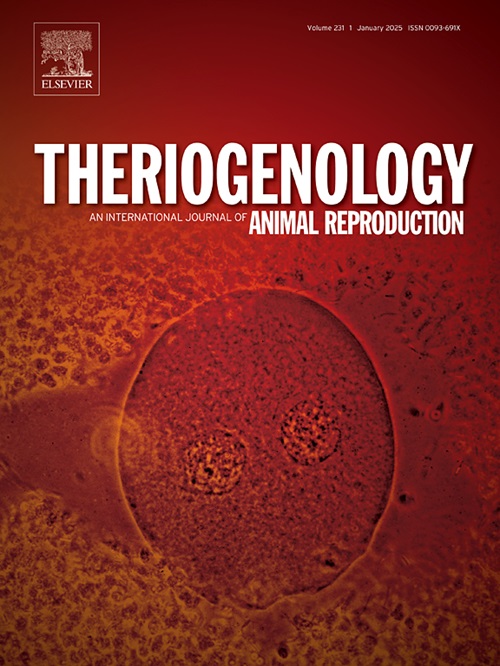Multidimensional data analysis algorithms facilitate and speed the analysis, and provide improved visualization of flow cytometry data in spermatology
IF 2.4
2区 农林科学
Q3 REPRODUCTIVE BIOLOGY
引用次数: 0
Abstract
Modern flow cytometers enable the simultaneous analysis of an increasing number of parameters or dimensions, offering significant advantages for andrological assessments. However, relying on conventional procedures for data processing increases the complexity of the analysis and the time required to complete it. We propose a simplified and efficient protocol that leverages commercial software and dimensional reduction algorithms for multiparametric flow cytometry data analysis, to improve data visualization and speed up the analysis. Ejaculates from six stallions were split into two media, a modified Tyrode's containing 67 mM glucose and 10 mM pyruvate or a commercial media containing 67 mM glucose but not pyruvate and stored at room temperature for 48 h. A five-color panel was designed to assess key sperm parameters, including viability, membrane permeability, mitochondrial membrane potential, mitochondrial mass, and apoptotic changes. Data were uploaded to FlowJo 10.10 for Mac, where automatic compensation and conventional 2D plot analyses were performed on the compensated files. In a second analysis, individual files were concatenated (merged) in FlowJo, generating new.fcs files, which were subsequently downsampled from 50,000 to 3000 events (spermatozoa) per file. The downsampled, concatenated files were exported and analyzed in Cytobank (https://premium.cytobank.org). Preprocessing included Arcsinh transformation for improved population visualization, automated compensation, and the exclusion of non-sperm debris, clumps, and doublets. Initial 2D plots were generated for each condition, providing a baseline comparison. Dimensionality reduction and clustering analyses were then performed on the same merged files. Our results showed that the proportions of sperm subpopulations identified by advanced analytical approaches, such as downsampling, dimensional reduction, and clustering, were consistent with those obtained via traditional 2D dot-plot analysis. This study demonstrates the feasibility and accuracy of advanced methodologies for flow cytometric analysis of spermatozoa. These approaches enhance processing speed, improve data visualization, and offer deeper insights into the dynamics of sperm subpopulations under varying metabolic conditions.
多维数据分析算法促进和加速分析,并提供精子学流式细胞术数据的改进可视化。
现代流式细胞仪能够同时分析越来越多的参数或维度,为男科评估提供显着优势。然而,依靠传统的数据处理程序增加了分析的复杂性和完成分析所需的时间。我们提出了一种简化和高效的协议,利用商业软件和降维算法进行多参数流式细胞术数据分析,以提高数据可视化和加快分析速度。将六匹公马的射精分成两种培养基,一种是含有67 mM葡萄糖和10 mM丙酮酸的改良Tyrode培养基,另一种是含有67 mM葡萄糖但不含丙酮酸的商业培养基,并在室温下储存48小时。设计了一个五色面板来评估精子的关键参数,包括活力、膜通透性、线粒体膜电位、线粒体质量和凋亡变化。将数据上传到Mac版的FlowJo 10.10,在其中对被补偿的文件进行自动补偿和传统的2D绘图分析。在第二次分析中,单个文件在FlowJo中被连接(合并),生成新的。FCS文件,随后从每个文件的50,000个事件(精子)降至3,000个。将下采样、连接的文件导出并在Cytobank (https://premium.cytobank.org)中分析。预处理包括用于改进种群可视化的Arcsinh变换,自动补偿,以及排除非精子碎片,团块和双峰。为每种情况生成初始2D图,提供基线比较。然后对同一合并文件进行降维和聚类分析。研究结果表明,通过降采样、降维和聚类等先进分析方法确定的精子亚群比例与传统的二维点图分析结果一致。本研究证明了精子流式细胞分析先进方法的可行性和准确性。这些方法提高了处理速度,改善了数据可视化,并对不同代谢条件下精子亚群的动态提供了更深入的了解。
本文章由计算机程序翻译,如有差异,请以英文原文为准。
求助全文
约1分钟内获得全文
求助全文
来源期刊

Theriogenology
农林科学-生殖生物学
CiteScore
5.50
自引率
14.30%
发文量
387
审稿时长
72 days
期刊介绍:
Theriogenology provides an international forum for researchers, clinicians, and industry professionals in animal reproductive biology. This acclaimed journal publishes articles on a wide range of topics in reproductive and developmental biology, of domestic mammal, avian, and aquatic species as well as wild species which are the object of veterinary care in research or conservation programs.
 求助内容:
求助内容: 应助结果提醒方式:
应助结果提醒方式:


